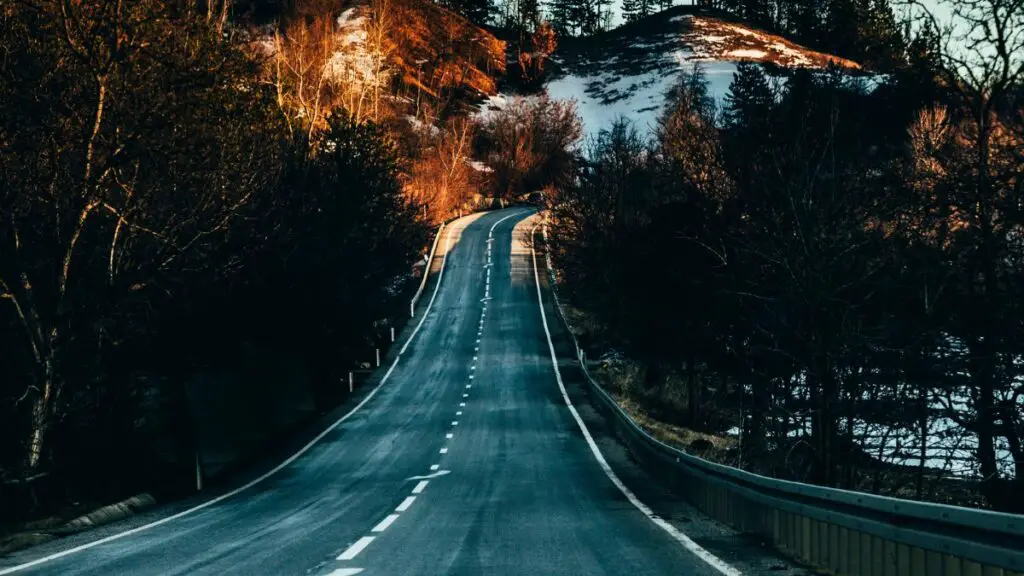This post may contain affiliate links. At no cost to you, purchases made through these links may result in a small commission for Traveling Transylvania. We never recommend products that we don’t know and trust. Thank you for your continued support!
Nestled in the heart of Eastern Europe, Romania stands as an enthralling blend of natural beauty, medieval architecture, and tales as old as time. As you venture into this captivating land, a Romania 7 day itinerary becomes synonymous with discovery, adventure, and cultural enrichment. Whether you’re diving into the folktales surrounding Dracula’s homeland in Transylvania, tracing the footsteps of royalty in Bucharest, or simply losing yourself in the serene Carpathian landscapes, Romania never ceases to amaze.
For those plotting a Romania 7 day itinerary, we’ve curated a comprehensive guide to ensure your travels encompass the essence of this magical nation. And if you’re specifically seeking a Romania itinerary that circles back to its starting point, you’re in luck.
This guide offers a beautiful route beginning in Bucharest, taking you through Transylvania, and returning back to Romania’s capital city. Though, you can technically begin and end in any of the cities we’ve included in this itinerary and circle your way back following the same route.
Prepare to immerse yourself in a journey of legends, breathtaking vistas, and historical marvels, as Romania unfolds its stories before you on this epic Romania 7 day itinerary.
- How Much Time is Enough in Romania?
- Getting Around Romania
- How to Use this Romania 7 Day Itinerary
- Romania 7 Day Itinerary
- Day 1: Bucharest & Brasov
- Day 2: Delving Deep into Brasov and Surroundings
- Day 3: Journey Through the Heart of Transylvania to Sibiu
- Day 4: Dive into the Cultural Delights of Sibiu
- Day 5: From Sibiu to Alba Iulia, and Onward to Cluj-Napoca
- Day 6: From Cluj-Napoca to Sighișoara
- Day 7: Sighișoara to Bucharest
- Romania 7 Day Itinerary FAQs
- Is Romania expensive to visit?
- Is Romania safe?
- Is it difficult to drive in Romania?
- Should I rent a car or take public transportation on a Romanian itinerary?
- What is the best time to visit Romania?
- Is the language barrier a problem in Romania?
- What kind of power outlets does Romania use?
- Are credit cards widely accepted in Romania?
- Embracing the Magic During Your Romania 7 Day Itinerary
How Much Time is Enough in Romania?
Romania, with its multifaceted beauty and depth, poses a tantalizing question to every traveler: How long is truly enough to explore its riches? On the surface, a week seems like an ample period to discover a country. However, in Romania, even this duration merely scratches the surface. A 7 day Romania itinerary will indeed provide you with a blend of culture, history, and nature, offering glimpses into the soul of Transylvania and the heartbeat of its cities.
However, there’s a saying among seasoned travelers and locals alike: Romania is a land where every turn reveals a new story, every village holds a centuries-old secret, and every landscape is a testament to nature’s grandeur. Having lived here for three years, I can personally attest to this sentiment.
Despite dedicating years to explore its vastness, I’ve only unraveled a fraction of what Romania has in store. The labyrinthine streets of its medieval towns, the untouched beauty of its national parks, the warmth of its people, and the richness of its traditions make Romania a place where each visit feels like the first.
While our Romania 7 day itinerary aims to capture the essence of the country in a week, the true charm of the country lies in its depth. The extended stays, the unplanned detours, the conversations with locals — that’s where the magic truly unfolds. So, while a week is a good starting point, it’s just the beginning of a lifelong romance with this enchanting land.
Getting Around Romania
Navigating Romania offers travelers a fascinating journey through time, with modern highways contrasting beautifully against rustic countryside trails. Whether you’re cruising through bustling cities or meandering through scenic byways, each mode of transport presents its own unique experience.
By Car: Renting a car is, without doubt, the most flexible way to explore the Romanian landscape. The liberty of driving lets you uncover hidden gems, from remote monasteries nestled in mountain ranges to untouched rural hamlets.
- Roads: Romania boasts a mix of road types. Some countryside areas, particularly in the mountains, might have narrower and rougher roads.
- Vignette (Road Tax Sticker): To use Romania’s national roads, you need a vignette (rovinieta). It can be purchased online, at border points, or gas stations.
- Local Customs: Expect to see horse-drawn carts, especially in rural areas. They usually stick to the right side, but always approach with caution. Keep an eye out for shepherds guiding their flock across roads too.
- Parking: In cities like Bucharest, Cluj-Napoca, and Sibiu, parking can be challenging. Opt for accommodations with parking or use designated parking lots.
By Train: Romania’s train network, operated mainly by CFR, connects major cities and towns. The experience can be quite scenic, especially routes crossing the Carpathian mountains. However, they can sometimes be slower than driving.
By Bus: Inter-city buses are efficient and often faster than trains. Companies like FlixBus, Autogenn, and MementoBus offer comfortable and regular services.
Cycling: In cities like Cluj-Napoca and Timisoara, cycling is becoming increasingly popular. Dedicated bike lanes and rental stations are available, though always be cautious as traffic can be unpredictable.
Tips for Renting a Car on Your Romania 7 Day Itinerary
- Reputation Matters: Stick to reputable companies. Look for reviews or recommendations.
- Inspect the Car: Before heading out, check for any existing damage. Ensure it’s noted in the agreement to avoid any future disputes.
- Understand the Insurance: Familiarize yourself with the insurance options provided. Collision Damage Waiver (CDW) and Liability Insurance are essential.
- Fuel: Romania has both petrol and diesel fuels. Make sure you know what your rental car requires. Also, while major towns have plenty of gas stations, fill up when you can if heading into more remote areas.
How to Use this Romania 7 Day Itinerary
Our Romania itinerary begins and ends in Bucharest. However, you can feel free to begin and end in any of the cities included in the itinerary. You’ll follow the same route.
We’ve really included a lot of activities in this Romania 7 day itinerary. You can pick and choose what your priorities are and go from there! Don’t feel like you have to do it all. Unless, of course, you want to!
Our Romania 7 Day itinerary is great for first-time visitors to the country. If you’ve already been to Romania, you may have already seen many of the attractions we’ve included here. In the coming weeks I’ll be working on a longer itinerary that is better suited to visitors who have already hit the main sites in the Romania 7 day itinerary.
Feel free to reach out to me if you have any questions!
Romania 7 Day Itinerary
Day 1: Bucharest & Brasov
Palace of Parliament
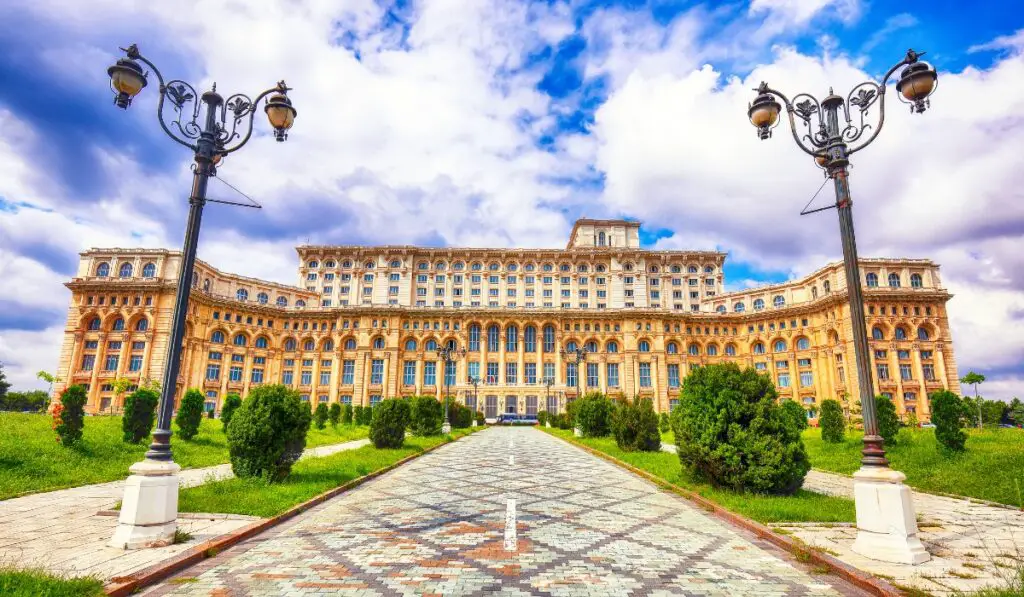
The Palace of the Parliament in Bucharest stands as an enduring testament to the ambitions and excesses of the Communist era, particularly under the rule of Nicolae Ceaușescu.
Spanning an astounding 330,000 square meters, it’s not only the heaviest building in the world but also the second-largest administrative building, surpassed only by the Pentagon in the U.S. Its mammoth size and grandeur are reflections of Ceaușescu’s vision of creating a structure that would represent Romania’s greatness and his own personal legacy.
Constructed over thirteen years, from 1984 to 1997, this colossal edifice is made up of 12 stories (with four additional underground levels) and houses the Senate and the Chamber of Deputies, among other entities. Its interiors are a lavish showcase of crystal chandeliers, mosaics, oak paneling, marble, and gold leafing.
Visitors to the palace can embark on guided tours, which I recommend. These include grand halls, balconies with panoramic views of the city, and glimpses into some of the building’s 1,100 rooms.
The Palace’s sheer opulence combined with its controversial history—built at the cost of demolishing much of Bucharest’s historical district and displacing thousands of residents—makes it a deeply intriguing landmark that sparks curiosity and reflection on the nation’s past.
Bucharest Old Town
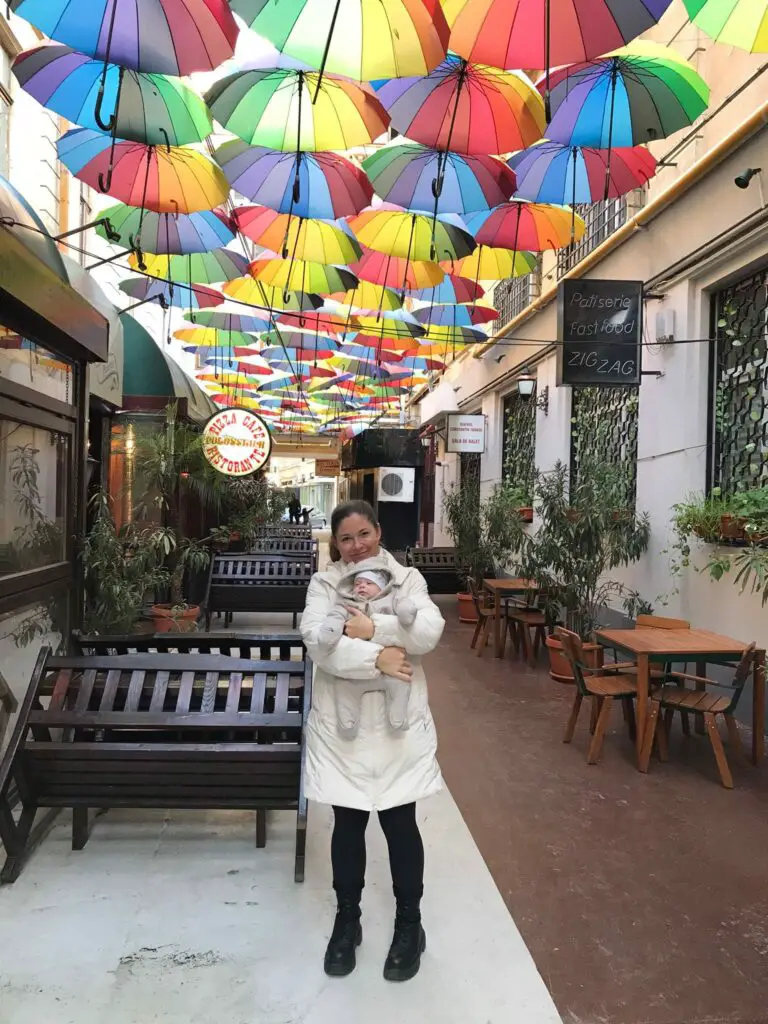
Nestled in the heart of Romania’s bustling capital, Bucharest’s Old Town, locally known as “Centrul Vechi”, is a vibrant tapestry of history, culture, and entertainment. This historic district encapsulates the spirit of the city. As you wander its narrow cobblestone streets and eclectic mix of architecture, you’ll span the epochs from medieval times, through the Belle Époque, and onto the more modern eras.
You’ll encounter ornate churches, like the Stavropoleos Monastery, standing beside neoclassical mansions and remnants of the ancient city walls. The Old Court Palace, once the residence of Vlad the Impaler, famously known as Dracula, is another gem waiting to be explored.
Caru’ cu Bere
Choose a local restaurant in the Old Town for a quick lunch before making the journey to Brasov. Caru’ cu Bere is a historical beer hall serving traditional Romanian fare in a gothic setting.
Journey to Brasov
Set out for Brasov. The drive from Bucharest to Brasov is approximately 3 hours without extended stops, but the journey is filled with scenic and historic places worth pausing for.
Peles Castle
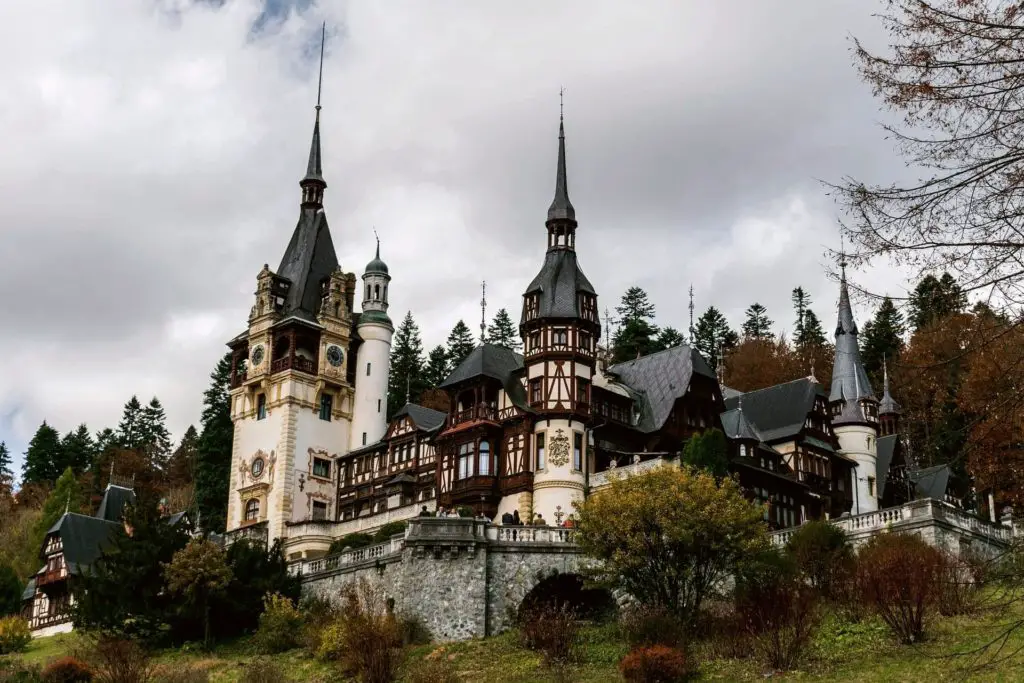
Perched amidst the scenic backdrop of the Carpathian Mountains in Sinaia, Peleș Castle is a masterpiece of Neo-Renaissance architecture. It’s also one of Romania’s most iconic landmarks. Commissioned by King Carol I in 1873, the castle served as the summer residence for the Romanian royal family.
Its exterior boasts intricately carved wooden details, spires, and frescoes. The interior is a grand showcase of European art, stained glass, ornate woodwork, and lavish furnishings. Every room tells a story, reflecting a distinct architectural style, from the Moorish Salon to the Florentine bedroom.
After your visit at Peles, continue on with your drive towards Brasov. The route takes you through the picturesque Prahova Valley, offering sweeping views of the Carpathian Mountains.
Piața Sfatului
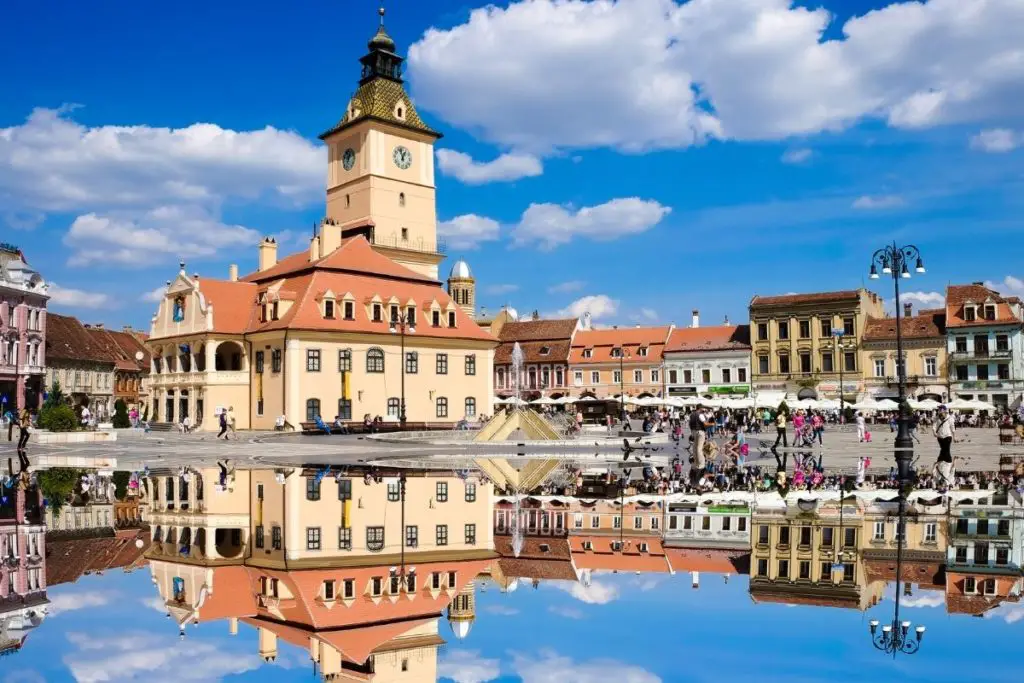
After you’ve arrived in Brasov and freshened up at your hotel, head to the Council Square in Brasov’s Old Town. It’s vibrant in the evening, surrounded by colorful baroque buildings and the Black Church. Dine at one of the local restaurants. La Ceaun is a great option, serving hearty Romanian stews.
Overnight: Stay in Brasov. The city offers a range of accommodations from luxury hotels to quaint bed and breakfasts. Casa Wagner in the heart of the Old Town is a charming choice.
Notes: While driving, ensure you adhere to Romanian speed limits and driving etiquettes. Watch for signs indicating the need for a rovinieta (road tax sticker). If not purchased during car rental, they can be obtained from gas stations. Ensure you also have the appropriate fuel type (petrol/diesel) as refueling stations might become sparse in certain stretches.
Day 2: Delving Deep into Brasov and Surroundings
La Birou Bistro
Start your day with a traditional Romanian breakfast at a local eatery. La Birou Bistro offers a yummy mix of local and international breakfast choices amidst a rustic setting. You’ll need a hearty start to the day, with so many things to do in Brasov.
The Black Church
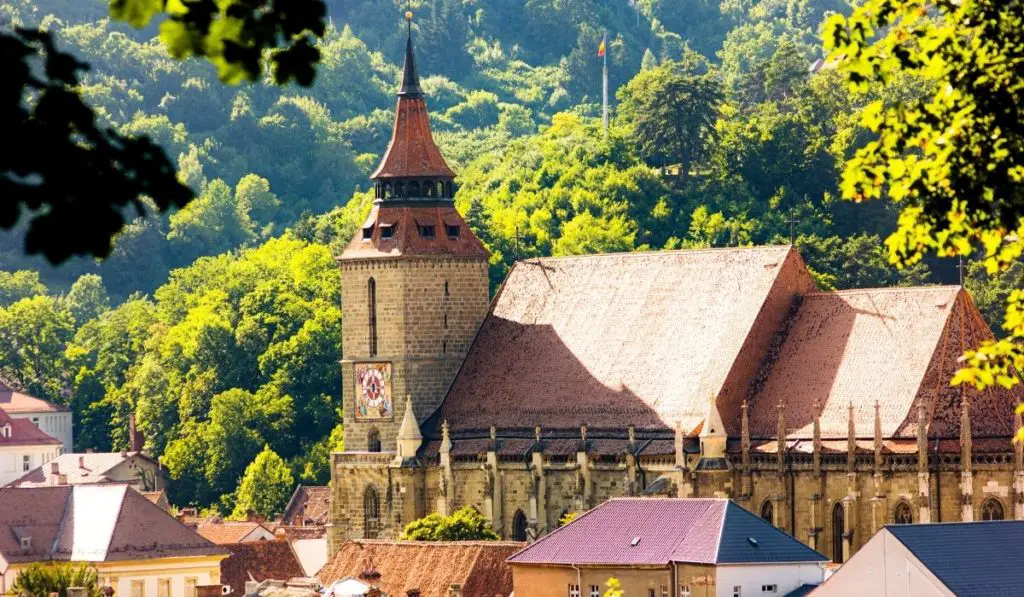
Dominating the skyline of Brașov, The Black Church stands as a majestic testament to Gothic architecture in Romania. With its origins dating back to the 14th century, it’s the largest Gothic church in the country.
The church earned its name after a catastrophic fire in 1689 blanketed its walls with a layer of dark soot. Beyond its impressive façade, the interior captivates visitors with a vast collection of Anatolian carpets, a colossal 4,000-pipe organ that fills the space with harmonious melodies, and medieval frescoes.
Strada Sforii
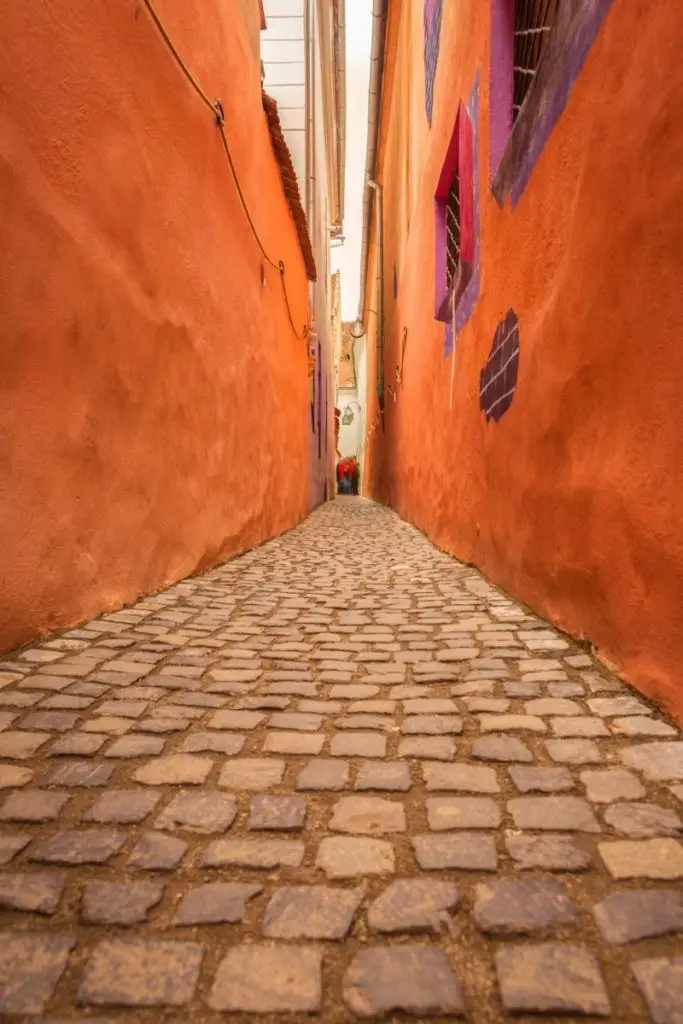
Take a jaunt down the ‘narrowest street in Europe’. Translated as “Rope Street”, its origins trace back to the 17th century when it was used as a corridor for firefighters. Measuring between 111 and 135 centimeters in width, this slender passageway exudes a unique charm, characterized by its cobblestone pavement and the proximity of its medieval walls, which seem to almost touch each other.
Tampa Mountain
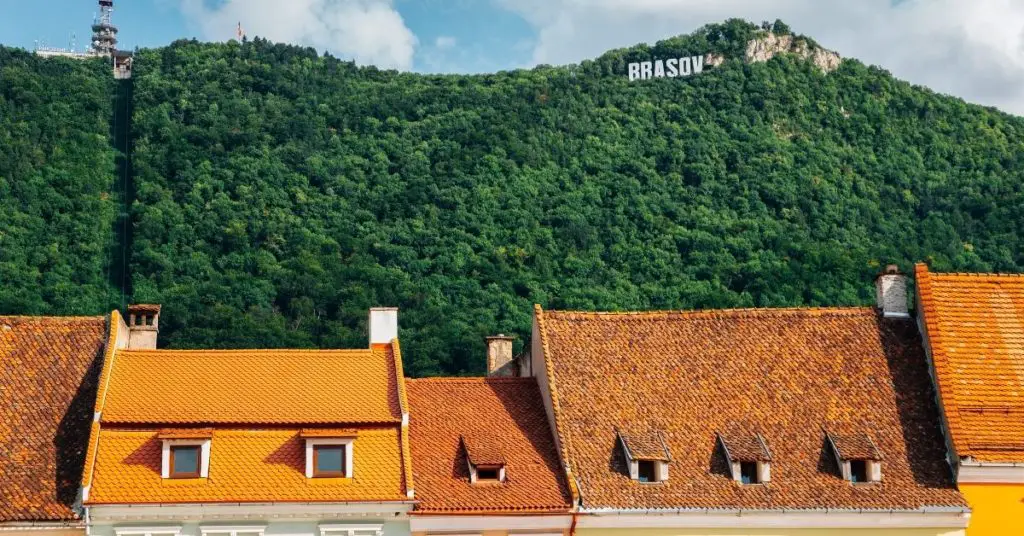
Overlooking Brașov, Tâmpa Mountain stands as a natural sentinel, its peak reaching an elevation of 960 meters. This limestone bastion has not only become emblematic of the city but is also a haven for nature enthusiasts and those seeking panoramic views of Brașov.
One of the most distinctive features of Tâmpa is the large “Brașov” sign. Reminiscent of the Hollywood sign, it’s illuminated at night and can be seen from various points in the city. A series of trails lead up to the summit, with some routes being more challenging than others. For those preferring a more leisurely route, take the Tâmpa Cable Car for a swift and scenic ride up.
Dei Frati
Head back to the city and enjoy lunch at Dei Frati, serving Italian dishes with a twist in Casa Wagner. While traditional Romanian food is undoubtedly delicious, if you’re not accustomed to eating it every day, it can get old pretty quickly. This Italian lunch is the perfect option to reset your tastebuds.
Rasnov Citadel
Perched atop a rocky hill, the Râșnov Citadel stands as a stoic reminder of Transylvania’s turbulent past. Situated close to Brașov, this medieval fortress was strategically erected in the 13th century as a defense against invading forces, including the Tatars and the Ottomans. Beyond its military function, the citadel also served as a place of refuge for the local inhabitants during prolonged sieges.
The fortress itself is a labyrinth of stone walls, towers, and ancient dwellings. Within its confines, traces of the past can be found at every corner, from the old well that was said to have taken decades to carve into the mountain, to the ruins of a chapel. As you wander its pathways, you’ll be met with sweeping vistas of the surrounding countryside and the town of Râșnov below.
One of the unique features of the citadel is its intentional lack of a water source, which led to the legend of two Turkish prisoners who were promised freedom if they succeeded in locating a water spring. They allegedly dug for 17 years, resulting in the deep well that exists today.
Bran Castle
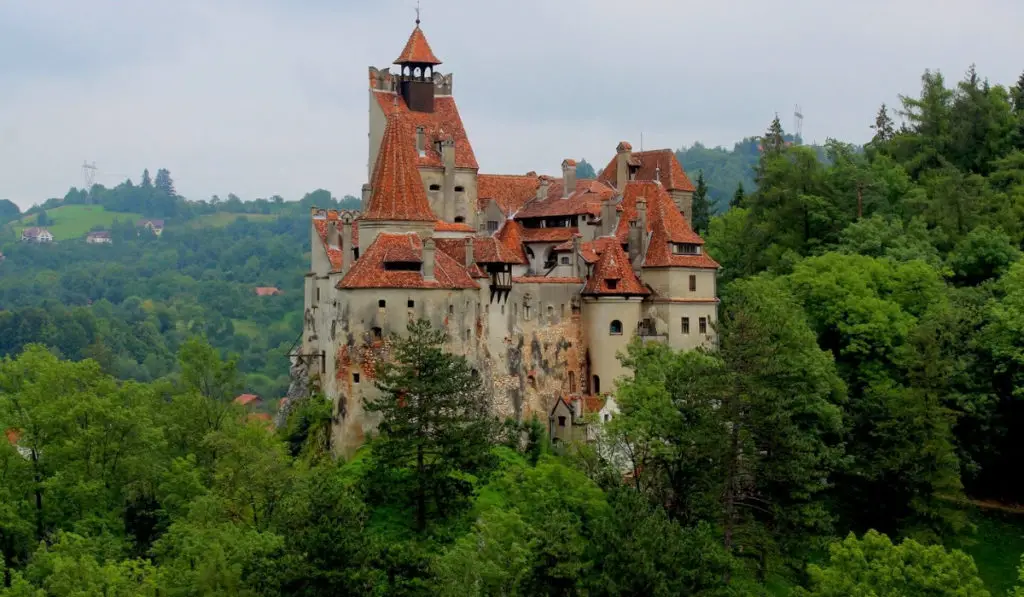
Often dubbed Dracula’s Castle, Bran Castle is one of Romania’s most visited landmarks, drawing visitors with its ties to Bram Stoker’s legendary vampire and its imposing Gothic architecture.
Situated near Brașov, the castle dates back to the 14th century and originally served as a fortress to protect against invasions. While its historical connection to Vlad the Impaler, the inspiration for Dracula, is debated, its atmospheric rooms, secret passages, and rich history make it an essential stop in Transylvania.
And if you happen to be visiting in October, be sure to check out their annual Halloween party!
Back in Brasov
Return to Brasov. As the sun sets, take a leisurely walk in the Council Square, appreciating the city’s ambiance under the warm glow of street lights.
Albert Social Bistro
Dine at Albert Social Bistro, known for its delightful fusion of Romanian and European cuisines in a cozy setting. Despite being in the heart of the Old Town, this restaurant doesn’t give off the same tourist-y feel as some of its neighbors.
Overnight: Continue your stay in Brasov. For those wanting a luxurious experience, Aro Palace offers lavish rooms with modern amenities, all within the charm of Brasov’s surroundings.
Notes: The journey between Rasnov and Bran is scenic and short, taking approximately 15 minutes. While Bran Castle is often associated with Bram Stoker’s Dracula, it’s essential to differentiate between the myth and historical facts about Vlad the Impaler.
Day 3: Journey Through the Heart of Transylvania to Sibiu
La Republique
Start your day early with breakfast at La Republique, renowned for its mix of French and Romanian morning delicacies. No better way to start the day than with some French crepes!
Leave for Sibiu
Kickstart your journey through the heart of Transylvania to Sibiu. The drive from Brasov to Sibiu takes approximately 2.5 hours, but with scheduled stops at key locations, you’ll experience some of the best of Romanian culture and scenery.
Făgăraș Fortress
One of the most imposing medieval strongholds in Romania, Făgăraș Fortress is a symbol of the country’s rich defensive architecture and storied past. Located in the town of Făgăraș, the fortress was initially built of wood in the early 14th century, but was later reconstructed in stone to serve as a formidable deterrent to potential invaders.
Inside the fortress, visitors can explore the Făgăraș County Museum, which offers insights into the region’s history, archaeology, and ethnography. With artifacts spanning centuries, it provides a comprehensive look into the area’s past.
Transfăgărășan Road
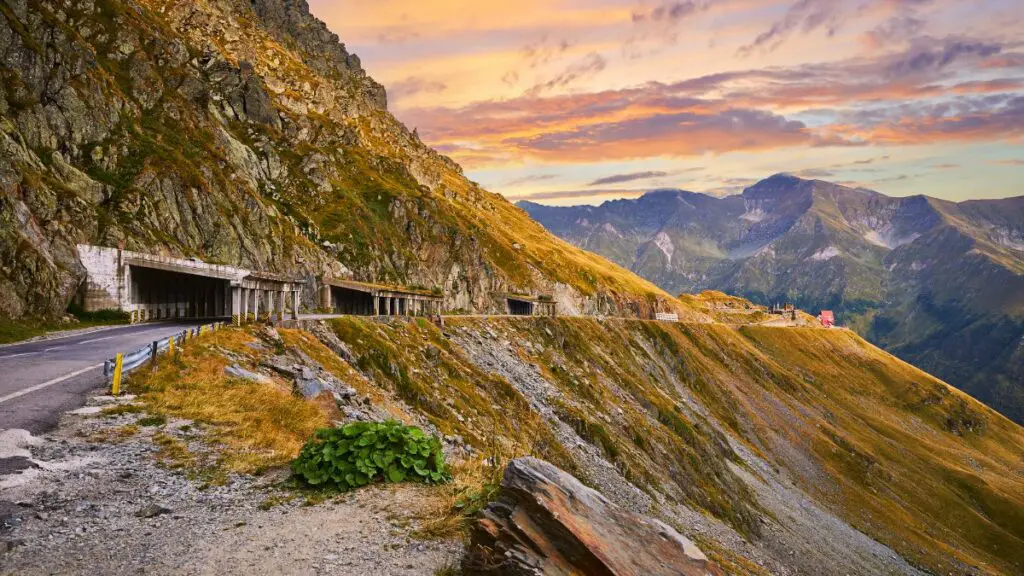
Embark on the Transfăgărășan Road, often touted as one of the world’s most scenic drives. This mountainous path, snaking its way up and through the Carpathian peaks, offers breathtaking vistas at every turn. Make sure to stop at viewing points and capture these memorable landscapes. Keep in mind that this road is only open seasonally. You won’t be able to take this route from October through June.
Balea Lake
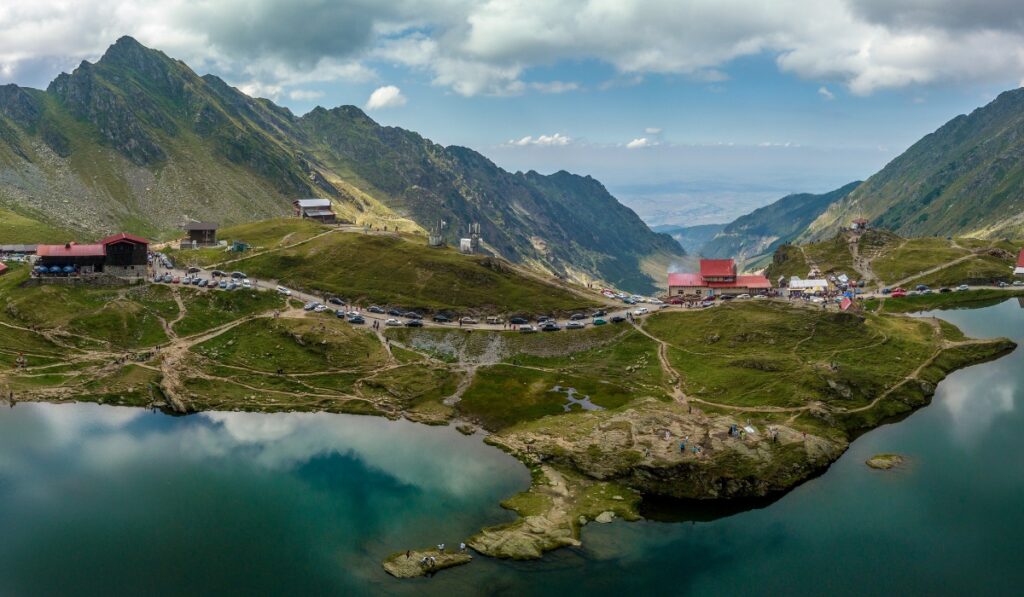
Stop at the crown jewel of the Transfăgărășan route – Balea Lake. Encircled by snow-capped peaks, Balea Lake is a glacial lake with a true ethereal beauty. Spend some time here, and if you’re feeling adventurous, there are short hikes around the lake. Don’t forget your camera.
Arrival in Sibiu
Arrive in Sibiu, one of Europe’s most idyllic cities and a former European Capital of Culture. Not to mention, my old stomping grounds during the 2020 lockdown and my favorite city in Romania! After checking into your hotel and freshening up, take a casual evening walk around the Old Town, taking in the sunset over the Council Tower.
Crama Sibiul Vechi
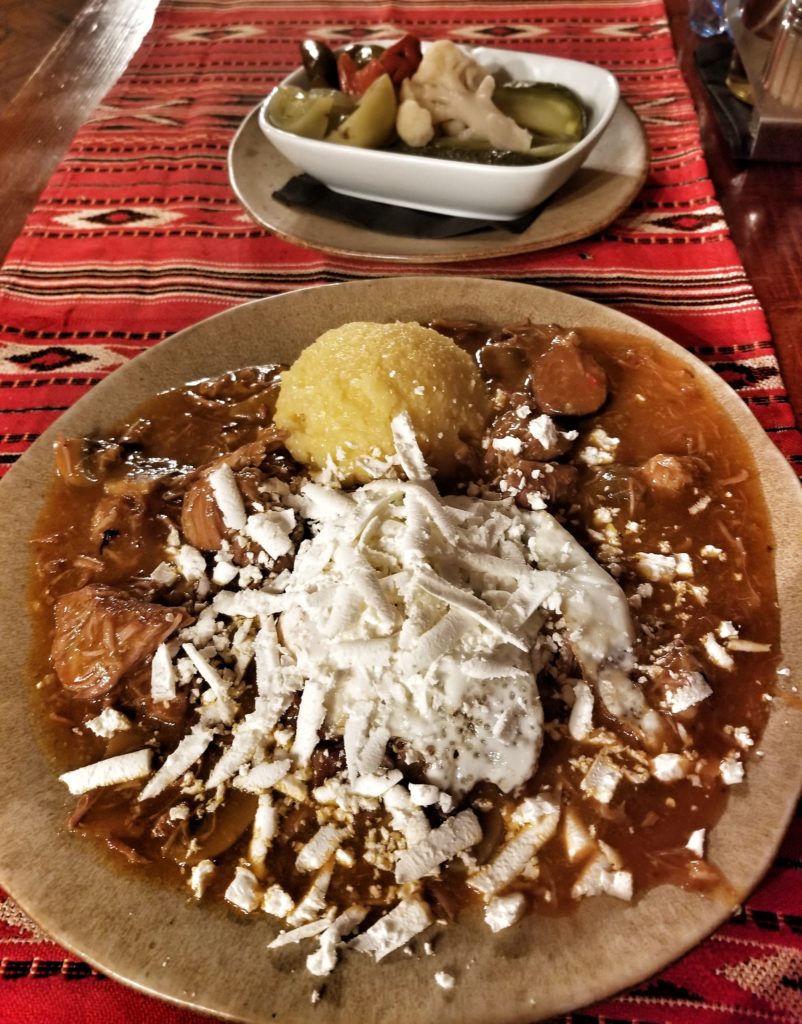
For dinner, head to Crama Sibiul Vechi, nestled in a 15th-century cellar and offering a fusion of Transylvanian and international dishes. The ambiance here, coupled with (occasional) live Romanian folk music, is enchanting. As usual, I like the tochitura and of course, a side of pickles.
Overnight: Stay in Sibiu. Consider the Împăratul Romanilor, a four-star hotel located in the heart of the Old Town. It’s rumored to be the oldest hotel in the country!
Notes: The Transfăgărășan Road is seasonal and is usually open from June to October. Before your trip, check for any road closures. Also, driving on this road requires careful attention due to its winding nature. Ensure your vehicle is in good condition, especially the brakes, and be prepared for changing weather conditions.
Day 4: Dive into the Cultural Delights of Sibiu
Cafe Wien
Start your day with a breakfast at Café Wien, known for its Austrian-inspired pastries, complemented by a blend of Romanian coffee. Its location right on one of Sibiu’s enchanting stairways is a great place to take photos during golden hour, if you’re up that early!
Piata Mare
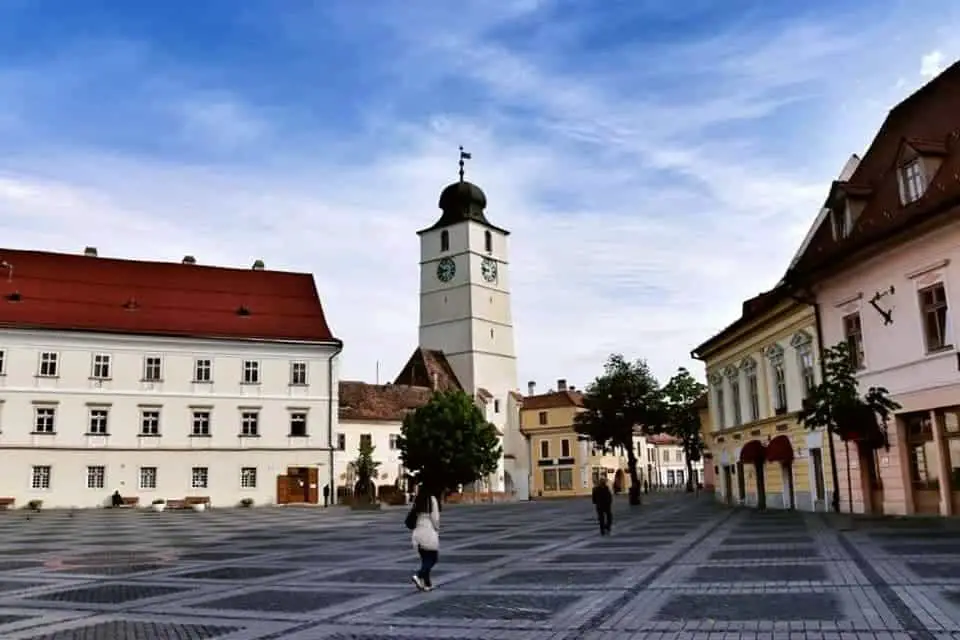
At the heart of Sibiu, a city steeped in history and culture, lies Piața Mare, or The Grand Square. Established in the 15th century, this expansive square has been the epicenter of the city’s public life for centuries, playing host to markets, fairs, public executions, and significant events.
One of the square’s most iconic features is the surrounding buildings characterized by their “houses with eyes.” These unique rooftop windows, resembling watchful eyes, gave the Baroque buildings a distinct appearance and have become symbolic of Sibiu itself.
They were originally designed for ventilation and lighting of the attics where goods were stored, but over time, they’ve taken on a more mystical quality in local lore, as if they keep a silent watch over the square’s happenings.
Today, Piața Mare is lined with cafes, shops, and historic landmarks, offering visitors a blend of the past and present. From the Brukenthal National Museum to the Council Tower, the square is a gateway to Sibiu’s rich history and vibrant culture, making it an essential stop for anyone visiting the region.
Council Tower
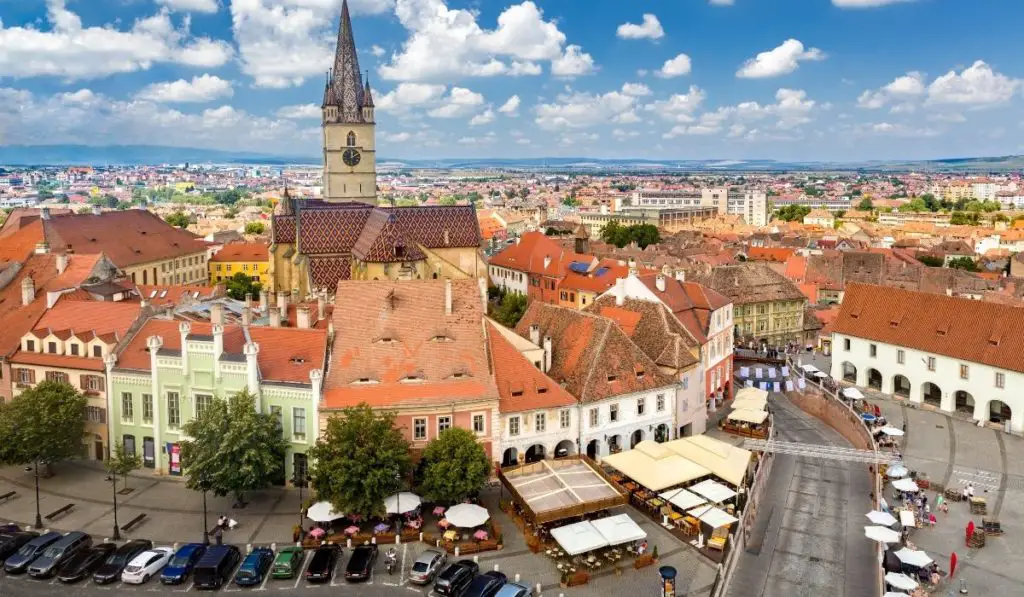
Standing sentinel over Sibiu’s historic center, the Council Tower, known locally as “Turnul Sfatului,” is one of the city’s most iconic landmarks. Dating back to the 13th century, this tower has undergone numerous transformations and reconstructions over the centuries, bearing witness to the many epochs of Sibiu’s evolution.
Originally built as a defensive gateway for the second fortified precinct, the tower has served a plethora of roles throughout its existence – from a grain deposit and a prison to a museum. Its name is derived from the building that neighbors it, the old City Council, emphasizing its administrative importance in earlier times.
Today, visitors can ascend the tower, navigating its spiral staircases to reach the top, where they are greeted with panoramic views of the city (see above photo). From the vibrant hues of Piața Mare to the red rooftops and “houses with eyes,” the vista from the Council Tower offers a unique perspective of Sibiu’s tapestry of history, architecture, and culture.
Piata Mica
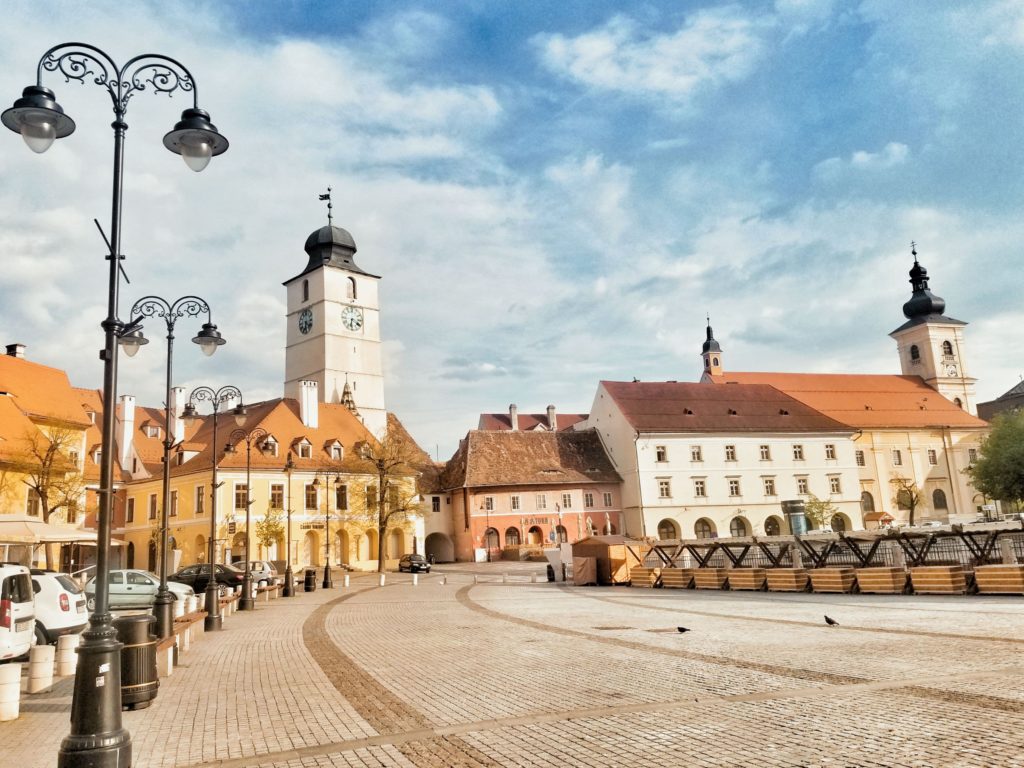
Adjacent to the more expansive Piața Mare lies Piața Mică, or “The Small Square,” another jewel in Sibiu’s historic center. With its slightly more intimate atmosphere, Piața Mică serves as the city’s cozy living room, where residents and visitors alike congregate for relaxation, dining, and leisure.
The square is surrounded by colorful Baroque houses with the signature “houses with eyes” rooftop windows, a distinct architectural feature of Sibiu. These houses, many of which now host charming cafes, boutique shops, and art galleries, add to the square’s picturesque and inviting ambience.
Piața Mică also houses some notable landmarks, including the “Liar’s Bridge” – a bridge enveloped in local legends and tales. According to popular lore, this iron bridge will creak and groan if any untruths are told while standing upon it.
Restaurant Hermania
Visit Restaurant Hermania, a restaurant that offers a delightful mix of Saxon and Transylvanian cuisine in an atmospheric setting. Definitely try the trout here, as they have a local fish farm in a nearby village where all of their fish is freshly sourced from.
Astra National Museum Complex
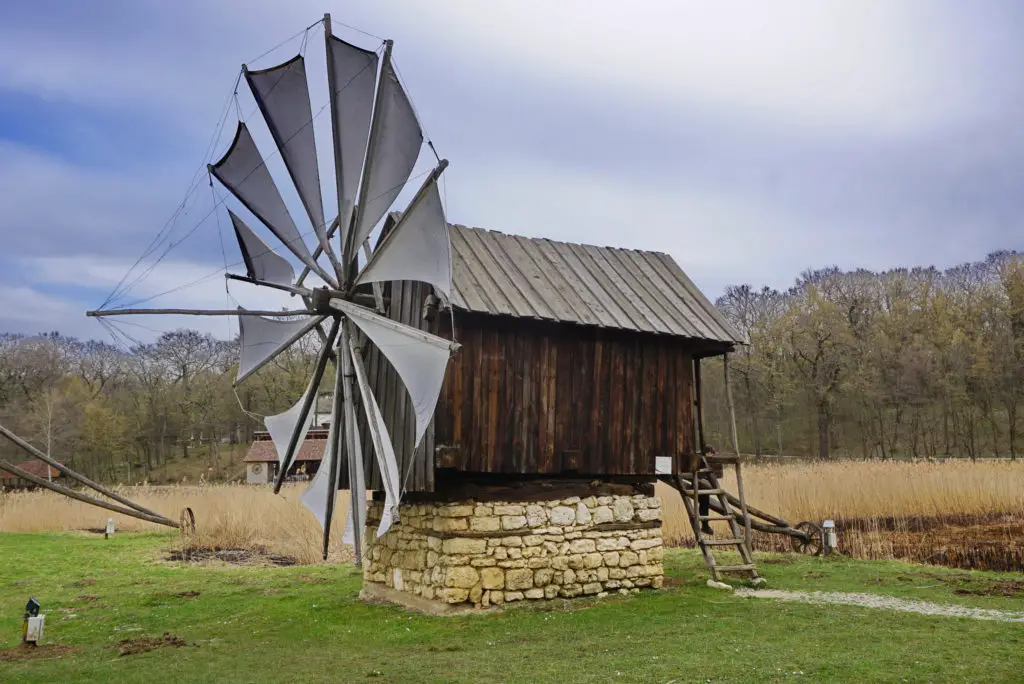
Nestled in the Dumbrava Forest, just a few kilometers south of Sibiu, the Astra Museum is a testament to Romania’s rich ethnographic and folkloric heritage. It’s the largest open-air ethnographic exhibition in Europe, sprawling over 96 hectares of lush landscape.
The museum showcases over 300 traditional buildings, from wooden churches and watermills to traditional Romanian farmhouses and artisan workshops. Each structure has been meticulously sourced, transported, and reconstructed from various parts of Romania. This provides a comprehensive overview of the country’s rural architecture and way of life.
Visitors can explore the thematic areas of the museum, which include zones dedicated to agricultural machinery, hydraulic installations, and traditional Romanian technologies. Moreover, the Astra Museum hosts numerous events throughout the year, including craft fairs, folk festivals, and workshops, where guests can immerse themselves in traditional activities like weaving, pottery, and woodworking.
St. Mary’s Evangelical Cathedral
Next, stop by Piata Huet to visit St. Mary’s Evangelical Cathedral. This Gothic masterpiece dates back to the 14th century. Its tall spire dominates Sibiu’s skyline. If you’re up for another climb, the tower offers a different vantage point of the city.
Cetatii Street
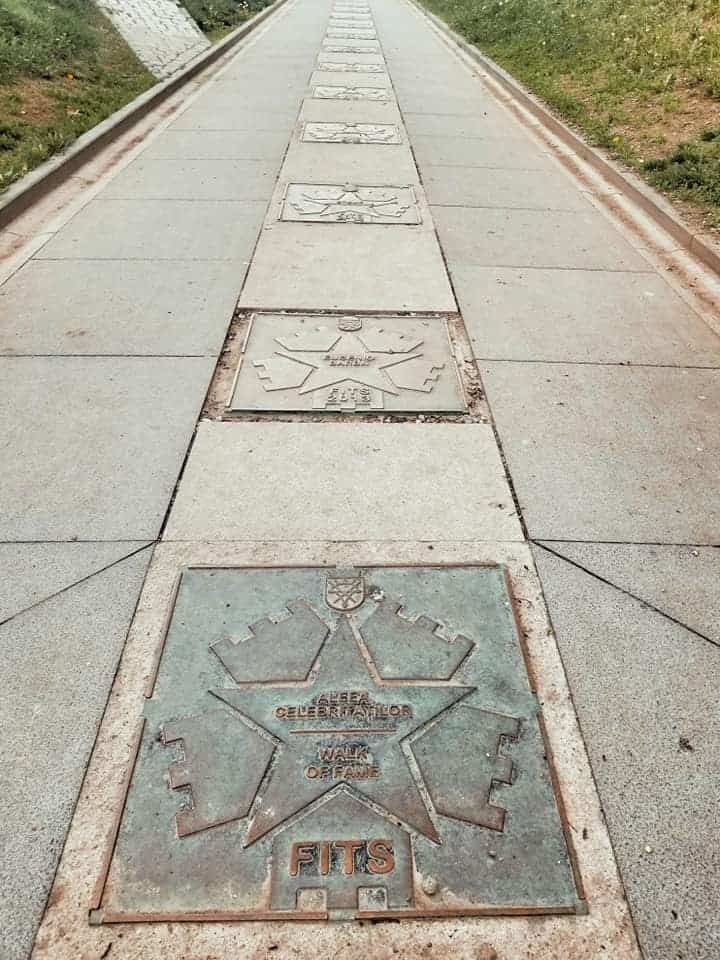
One of Sibiu’s most emblematic streets, Cetatii Street, is a splendid fusion of history, art, and urban charm. Lined with cobblestones and framed by historical edifices, the street exudes an aura reminiscent of medieval times while simultaneously embracing the vibrancy of modern-day Sibiu.
An integral part of the city’s historic fabric, Cetatii Street runs along the old city walls, vestiges of Sibiu’s fortified past. These walls, which once stood as protective barriers against potential invaders, now serve as silent witnesses to the city’s evolution over centuries.
Adjacent to the street is a quaint park that houses the “Sibiu Walk of Fame.” Here, commemorative plaques honor notable figures who have contributed significantly to the city’s cultural, artistic, and social landscape. This is where Andre and I spent many mornings trying to take in our exercise during the pandemic.
Pardon Cafe
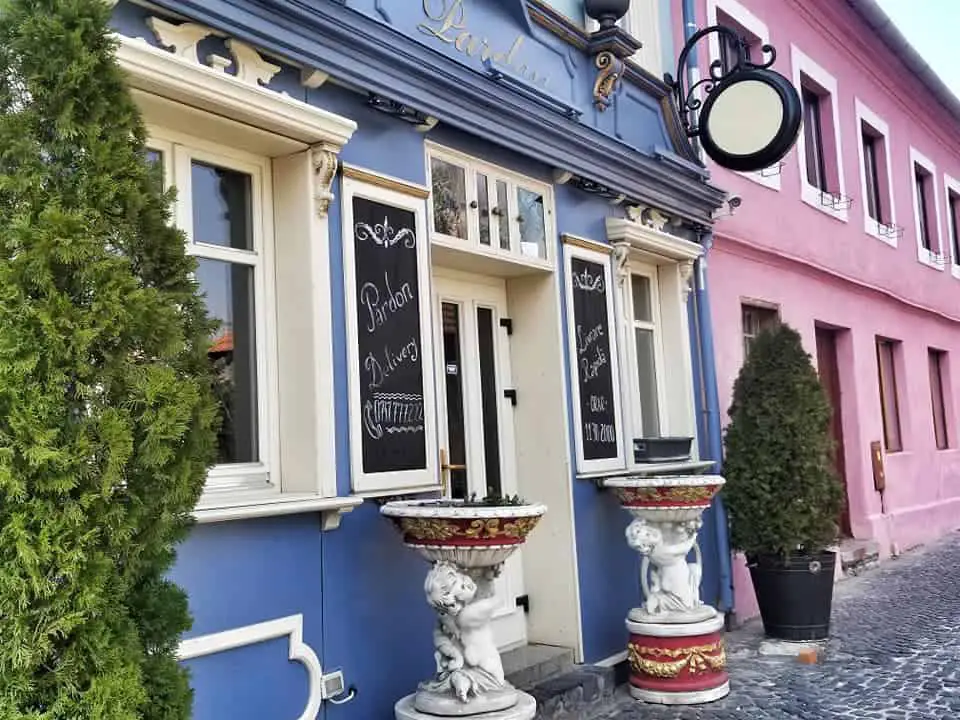
For a memorable dining experience, reserve a table at Pardon Cafe. This restaurant is one of the best places to eat in Sibiu. They offer an extensive wine list paired with gourmet dishes, right on Cetatii Street. Check out their Facebook page for videos of the chef whipping up the daily menu.
Overnight: Extend your stay in Sibiu. For a boutique experience, try Continental Forum Sibiu, just steps away from the Old Town.
Notes: While there are so many things to do in Sibiu, it’s essential to pace yourself. The beauty of the city is as much in its landmarks as in the little moments you’ll discover along the way — a local artisan at work, an impromptu street performance, or a quiet courtyard steeped in history.
Day 5: From Sibiu to Alba Iulia, and Onward to Cluj-Napoca
Hug the Mug
Grab a hearty breakfast at Hug the Mug, a trendy spot known for its contemporary takes on traditional breakfast dishes. Try their English Breakfast for a comforting start to the day.
Depart for Alba Iulia
Set out for Alba Iulia, a city deeply rooted in Romanian history. The journey takes about an hour, so you’ll have plenty of time to explore this fortress city.
Alba Carolina Citadel
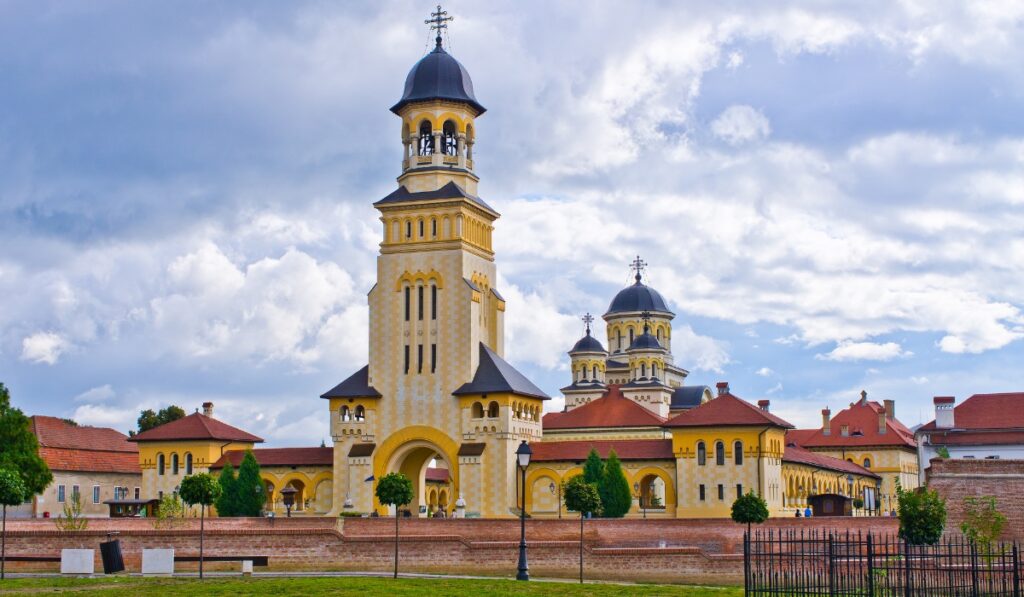
The Alba Carolina Fortress in Alba Iulia stands as a monumental showcase of Transylvanian history. This star-shaped structure, the largest fortress in Romania, reflects the Vauban-style military architecture of the 18th century during the Habsburg era. Built on ancient Roman and medieval foundations, its seven bastions are named after Roman Catholic saints.
Within its walls, you can see notable edifices like the Coronation Cathedral and St. Michael’s Cathedral. Not just a relic of the past, today it’s a lively space with museums, cafes, and cultural events, making it a key landmark for history buffs and casual visitors alike.
Union Hall
Union Hall and Union Museum is significant for the unification of Romania and Transylvania. Immerse yourself in the rich history, understanding the milestones that led to the formation of modern-day Romania.
Le Conac
Enjoy lunch at La Conac, a restaurant set in a historic mansion, offering a mix of traditional and modern Romanian dishes. You can’t go wrong with the coaste (ribs)!
Drive to Cluj-Napoca
Begin your journey to Cluj-Napoca. The drive is approximately 2 hours and 45 minutes, but the route offers scenic Transylvanian landscapes, so consider stopping for some spontaneous photo sessions along the way.
Turda Salt Mine
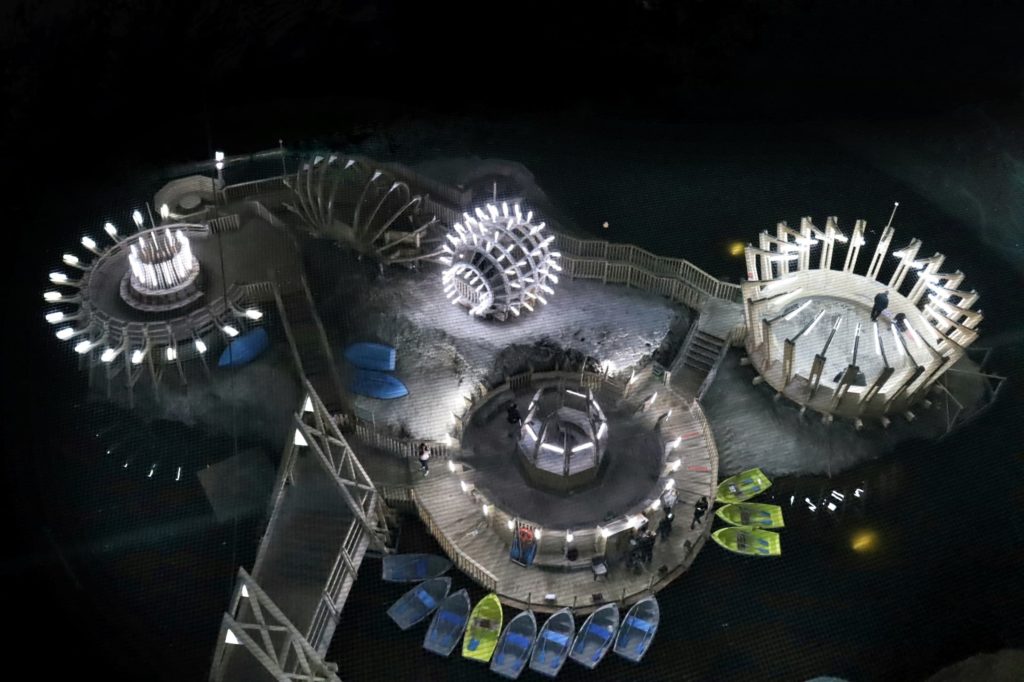
Before reaching Cluj, take a detour to the Turda Salt Mine, a unique attraction. Descend into the underground wonder, marveling at the cavernous halls, underground lake, and even a Ferris wheel! This place uniquely combines history with modern recreational amenities.
Arrive in Cluj-Napoca
Prepare for your arrival in Cluj-Napoca, the unofficial capital of Transylvania (and where I live!). After checking into your hotel, take a leisurely evening walk in Union Square (Piața Unirii), appreciating the mix of Gothic, Baroque, and Renaissance architecture.
Dinner at Nativ
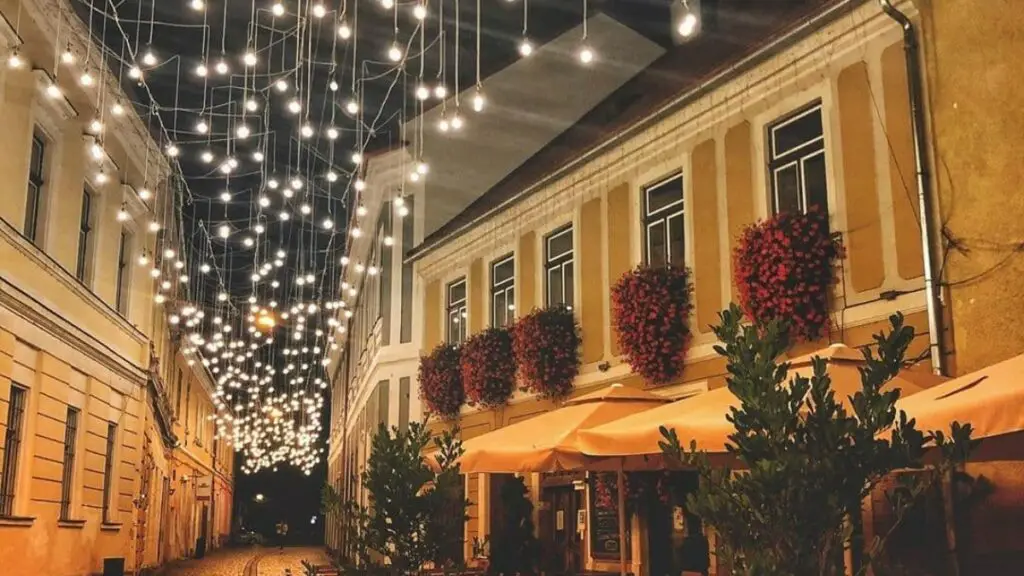
Dine at Nativ, one of the best restaurants in Cluj-Napoca. Nativ offers an upscale dining experience with a twist on Transylvanian cuisine in a chic setting – using exclusively Romanian products. After dinner, head next door to Klausen Pub House if you fancy a drink before heading back to your hotel. Be sure to check out the beautiful lights of Piata Muzeului.
Insomnia
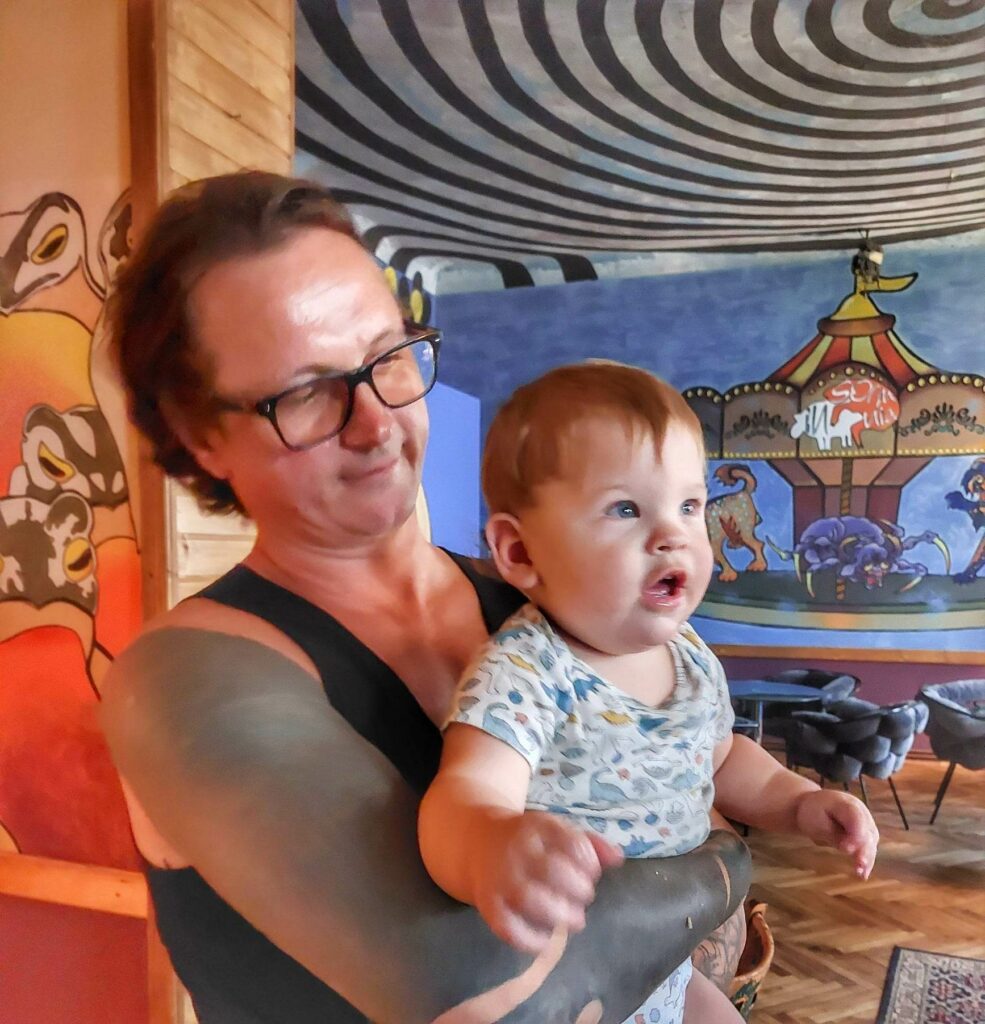
Not ready to end the night there? Dive into Cluj’s lively nightlife. Insomnia is a fun bar that is a local favorite and offers a range of craft beers, unique cocktails, and sometimes live music. As you can see, it’s one of Olly’s favorites, too.
Overnight: Settle in Cluj-Napoca. Hotel Grand Italia is a luxurious choice, combining modern elegance with a prime location close to the city’s main attractions.
Notes: Driving in Transylvania requires a keen eye for road signs, especially in areas prone to wildlife crossings. As you approach Cluj, the traffic might increase, so ensure you’re well-rested for this leg of the journey.
Day 6: From Cluj-Napoca to Sighișoara
Eggcetera
Begin your day at Eggcetera. Its diverse menu, from classic Romanian treats to international breakfast staples, ensures a hearty start.
Piața Unirii
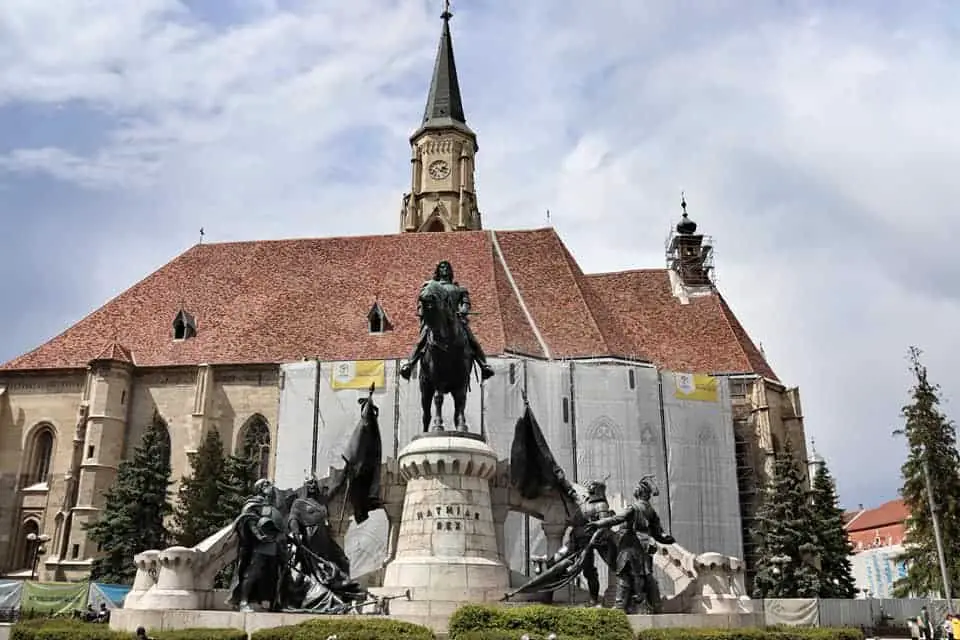
As one of the city’s main squares, it’s framed by baroque and gothic architectural marvels, with the imposing St. Michael’s Church standing as its iconic centerpiece. Around the square, visitors will find an array of cafes, shops, and historic buildings, narrating Cluj’s rich past. The Matthias Corvinus Statue, commemorating one of Hungary’s greatest kings, is another highlight.
Banffy Palace
Bánffy Palace, often referred to as the “Versailles of Transylvania,” is a gem of Baroque architecture nestled in Cluj-Napoca’s historic center. Commissioned by the influential Bánffy family in the 18th century, the palace showcases a sumptuous design replete with sculpted adornments, grand staircases, and spacious courtyards.
Today, Bánffy Palace serves as the home for the National Museum of Art of Cluj-Napoca, featuring an impressive collection of Romanian visual arts. Visitors are treated not only to the works of art within but also to the palace’s own architectural beauty and historical narrative, making it a must-visit for art enthusiasts and history buffs alike.
Central Park Simion Bărnuțiu
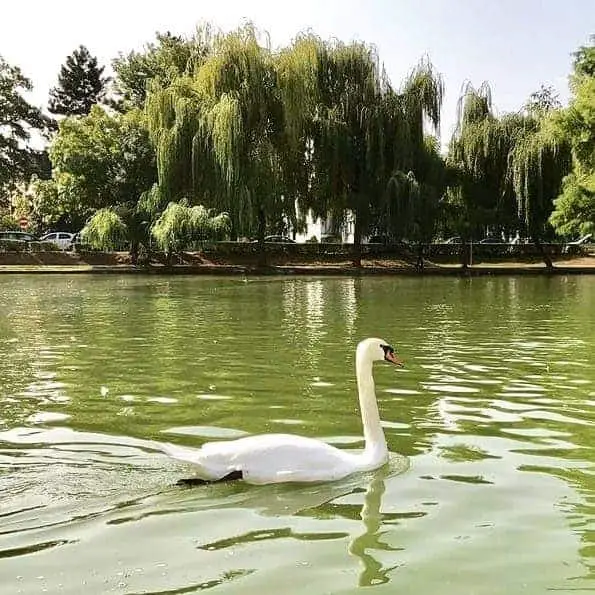
Central Park offers both locals and tourists a serene escape from the urban hustle. I spent a lot of time here this summer, since the hospital where Eli was staying is just across the street. Established in the 19th century, this verdant expanse boasts a picturesque lake at its center. Visitors wandering around the lake are often delighted by the sight of a pair of black swans – who are actually friendly enough to feed!
After a leisurely walk, many visitors stop for a refreshing drink or a bite at Collin’s, a popular restaurant toward the entrance of the park. With its inviting ambiance and panoramic views, it’s the perfect spot to relax and soak in the beauty of Central Park.
Lunch at Roata
Head to Roata for a traditional Transylvanian lunch. Their “Varza a la Cluj” (Cabbage à la Cluj) is a must-try! If you’re not sure what to order, consider getting one of their Transylvanian platters. Often made for 2 or more people, these platters showcase the most popular local dishes.
Head to Sighișoara
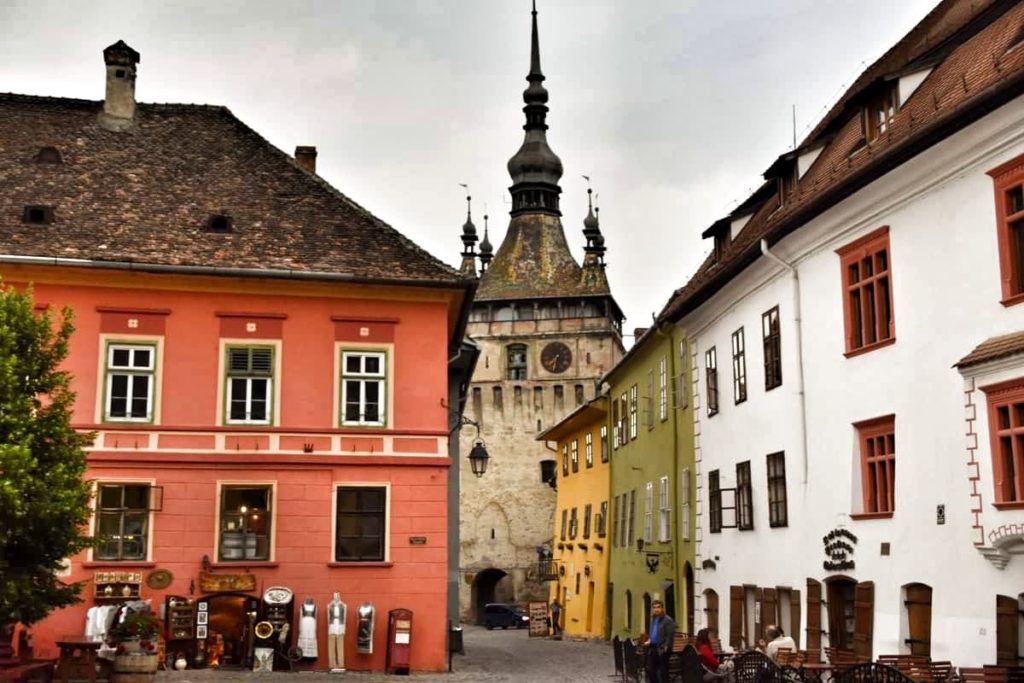
Arrive in UNESCO-listed Sighisoara after a 2.5 hour drive, to experience one of the best-preserved medieval towns in Europe – and our former home (albeit for only a few months).
Birthplace of Vlad the Impaler
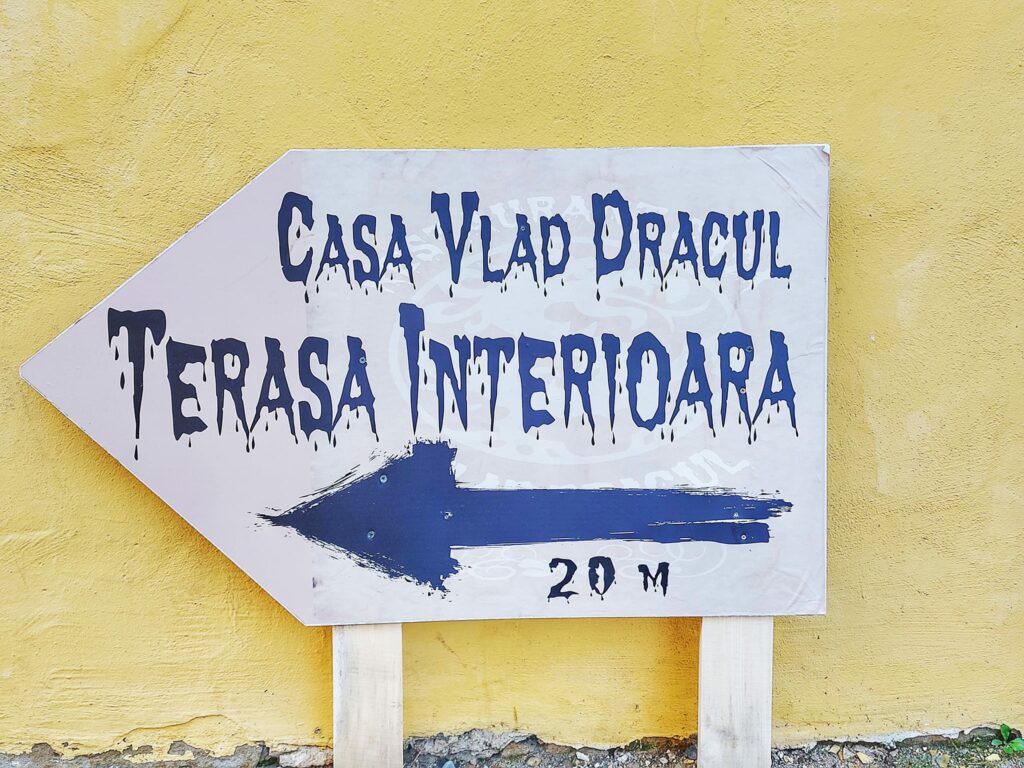
This ocher-colored house in the citadel square is where Vlad the Impaler, the inspiration behind Dracula, was born. Today, it operates as a small museum upstairs with some kitschy souvenir shops on the ground level.
Cafe Martini & Habermann
Dine at Cafe Martini, one of our favorite restaurants when we lived in Sighisoara. Just outside the Citadel, this restaurant offers some of the best food in town and is more far removed from the tourist radar. Try some traditional Transylvanian dishes with a historical twist.
My favorite dish here is the Dracula Tochitura, a spicy/garlicky Transylvanian stew. Their salads are also really yummy if you’re looking for something less heavy. Be sure to say hi to the staff from Szilard and I!
The Clock Tower
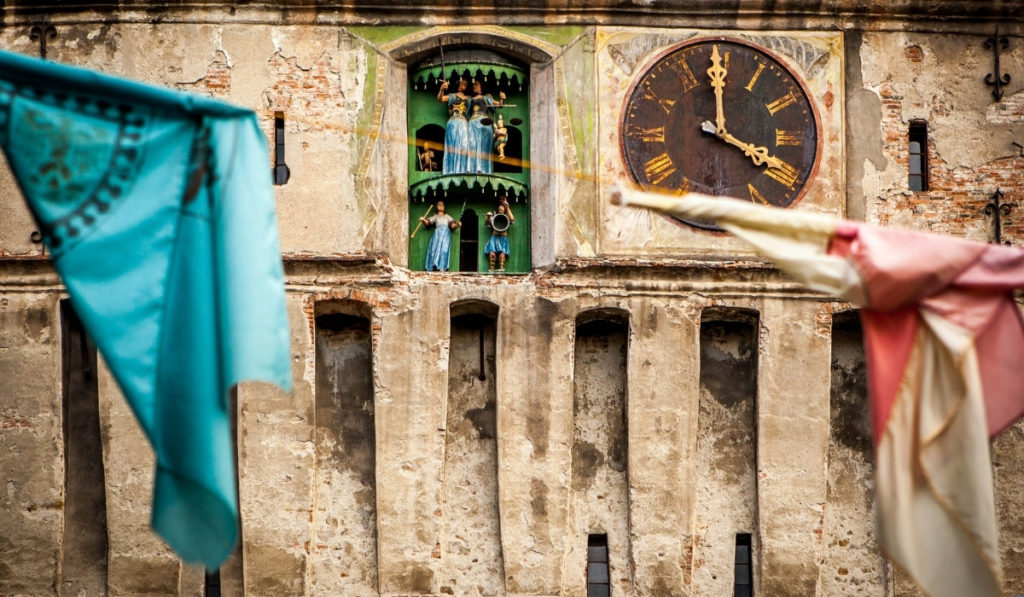
The Clock Tower is the defining landmark of Sighișoara, standing tall since the 14th century. As a former defensive gate, it’s adorned with intricate sculptures and boasts a colorful tiled roof. Inside, the tower houses a history museum.
But the true highlight for many visitors is ascending the tower to enjoy panoramic views of this UNESCO-listed medieval town. Its clock, with figurines that mark the passing of time, adds to its unique charm, making the tower a must-visit when in Sighișoara.
The Church on the Hill
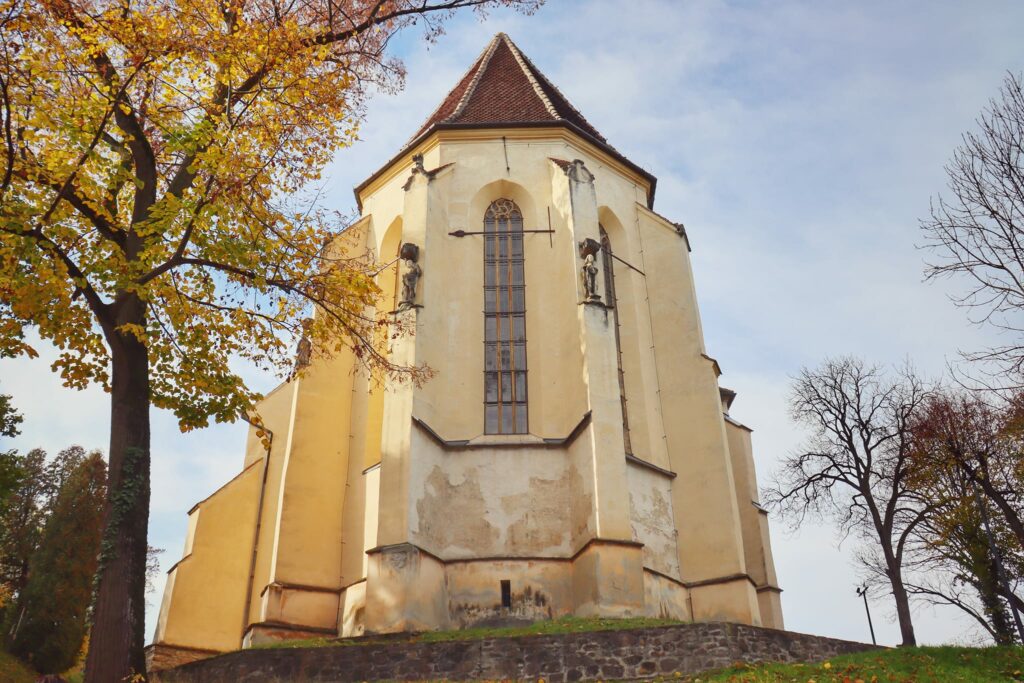
Dominating Sighișoara’s skyline, the Church on the Hill is a Gothic masterpiece dating back to the 14th century. As visitors ascend its steep pathway, they’re rewarded with stunning frescoes and medieval artistry inside. Adjacent to the church lies the evocative German cemetery, a solemn reminder of the town’s Saxon heritage. Together, they offer a profound blend of architectural beauty and historical depth, essential to any Sighișoara visit.
Explore the Guild Towers
Sighișoara’s Guild Towers are emblematic of the town’s medieval heritage and the protective nature of its historic trades. Each tower was constructed and maintained by a different craft guild, reflecting the strength and pride of Sighișoara’s artisan communities in the Middle Ages.
Ranging from the Bootmakers’ Tower to the Tailors’ Tower, each edifice stands as a testament to the specific guild it represented. These structures, with their distinctive architecture and prominence, serve not only as fortifications but also as enduring symbols of the town’s rich history and the pivotal role of its craftsmen.
Casa Georgius Krauss
Enjoy a hearty dinner at historical and cozy restaurant Casa Georgius Krauss, where you’ll find an upscale twist on traditional Romanian dishes. This is a great option for a date night. Their Balsamic Steak with Cipollini Onions is to-die-for.
Overnight: There are many pensiune and guest houses in Sighișoara, as well as some bigger-name brand hotels, such as the Hilton DoubleTree.
Notes: There isn’t much to do in Sighisoara at night, so plan for an early evening.
Day 7: Sighișoara to Bucharest
La Perla
Breakfast at La Perla, set in a charming corner building around the corner from Cafe Martini. Their omelets and cappuccinos are the best in town. Take one last walk around Sighisoara, perhaps purchasing souvenirs or local crafts.
Start your drive to Bucharest
It’s a longer journey today, so ensure you’re well-rested. You’ll spend about 4 hours on the road (without stops).
Cismigiu Gardens
Cismigiu Gardens, a verdant haven in the heart of Bucharest, is the city’s oldest public park. Established in the mid-19th century, it sprawls over 17 hectares, offering residents and tourists alike a delightful escape from urban bustle. Designed in the style of English gardens, Cismigiu showcases winding paths, ornate bridges, and a picturesque lake where visitors can enjoy row boat rides.
Throughout the park, statues of notable Romanian literary figures stand in homage to the nation’s rich cultural heritage. Whether it’s the sight of children playing, couples strolling, or the burst of colors during spring and autumn, Cismigiu Gardens encapsulates the timeless charm and tranquility of Bucharest’s beloved green space.
Carturesti Carusel
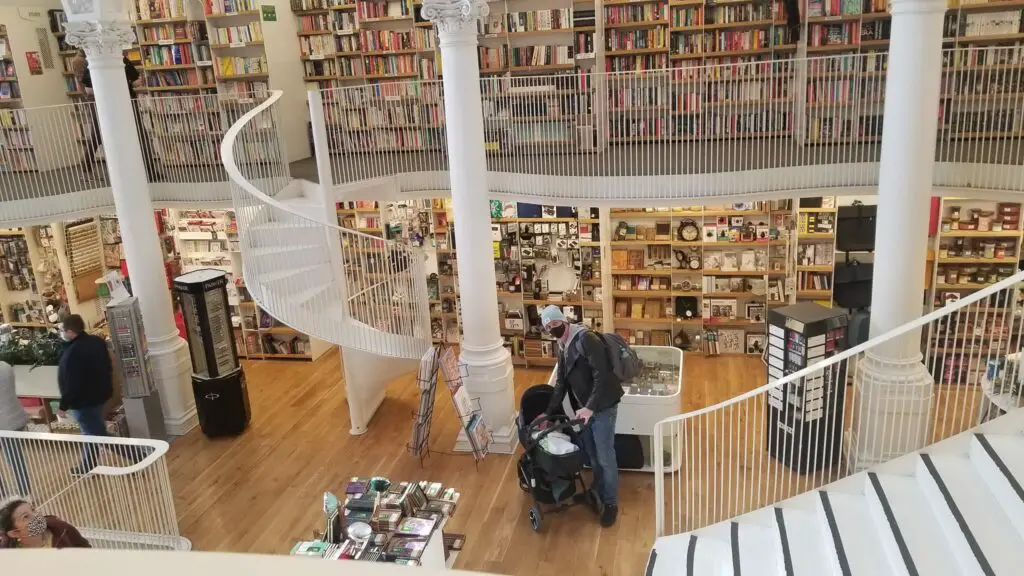
Visit the ‘Old Town’ of Bucharest and stop in this iconic bookstore, one of the most beautiful in the world. Wander its lively streets, filled with bars, restaurants, and shops, all set against a backdrop of historic buildings.
Le Bab
Dine at Le Bab, a historic and iconic restaurant in Bucharest. With its beautiful black-and-white terrace filled with greenery and flowering plants, you might feel as though you’re in Paris instead of Bucharest.
National Theatre
The National Theatre of Bucharest, located in the capital’s vibrant center, stands as an emblem of Romania’s esteemed theatrical tradition and architectural heritage. Originally inaugurated in the 19th century, the theater has undergone multiple renovations, each adding layers to its grandeur and historic significance.
With several halls, the theater stages a diverse repertoire, from classic Romanian plays to contemporary international productions, showcasing the breadth and depth of the country’s artistic talents. Beyond its performances, the edifice itself, with its opulent interiors and imposing façade, attracts architecture enthusiasts and history buffs. Attending a show or simply admiring its architecture, visitors are connected to Romania’s rich cultural tapestry.
As you conclude your Romanian journey, from the vibrant Bucharest to the medieval charms of Transylvania and back, you’re left with an album of memories – of historic tales, architectural marvels, and the unique tapestry of Romanian culture. Safe travels!
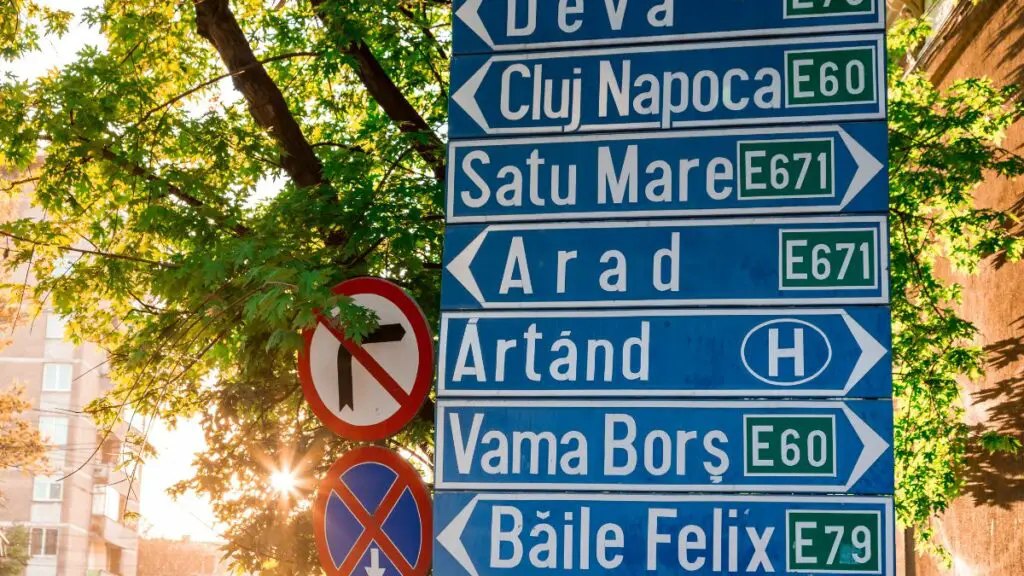
Romania 7 Day Itinerary FAQs
Is Romania expensive to visit?
Romania is considered one of the most budget-friendly destinations in Europe. Accommodation, food, and transportation are generally cheaper than in Western European countries. However, as with any travel destination, expenses can vary based on individual preferences and travel style. Tourist attractions, especially in major cities like Bucharest, may have prices on par with other European capitals, but rural and off-the-beaten-path areas can allow you to comfortably visit Romania on a budget.
Is Romania safe?
Yes, Romania is generally a safe country for tourists. Crime rates are relatively low, especially violent crimes against tourists. However, like anywhere else, it’s essential to be cautious and aware of your surroundings, particularly in crowded areas where pickpocketing might occur. Always take the usual travel precautions: don’t leave belongings unattended, be wary of scams, and avoid poorly lit areas at night.
Is it difficult to drive in Romania?
Driving in Romania is manageable for most experienced drivers. Roads vary in quality, with highways and main roads in good condition, while some rural roads can be challenging, especially in winter.
Romanian drivers are known to be somewhat aggressive compared to Western standards. It’s essential to be aware of local driving habits, like overtaking. Also, be cautious of horse-drawn carts in rural areas. The use of seat belts in the front seat is mandatory, and driving under the influence is strictly prohibited.
Should I rent a car or take public transportation on a Romanian itinerary?
Both options have their pros and cons. Renting a car provides the freedom to explore at your own pace and visit off-the-beaten-path locations. It’s especially useful if you’re keen to explore the countryside or smaller villages which might not be easily accessible by public transport.
On the other hand, Romania’s public transportation system, consisting of trains and buses, is relatively efficient and budget-friendly. For those not comfortable driving in a foreign country or those traveling solo, public transportation might be a more convenient choice.
Consider your itinerary, comfort level, and budget when making a decision. For our recommended Romania 7 itinerary, renting a car would provide the most flexibility and convenience.
What is the best time to visit Romania?
The best time to visit Romania largely depends on your preferred activities. For general sightseeing, spring (April to June) and autumn (September to October) offer pleasant weather and fewer crowds. Summer (July to August) is great for exploring the Black Sea coast, but tourist spots might be crowded. Winter (December to February) attracts skiing enthusiasts, especially in the Carpathian Mountains.
Is the language barrier a problem in Romania?
Romanian is the official language. In major cities, tourist areas, and among the younger population, English is widely spoken. German and French are also understood by some, especially in Transylvania. While in rural areas, English might be less common, locals are friendly and often go out of their way to help, even if it involves a bit of charades!
Check out our post on common Romanian travel phrases to get you started.
What kind of power outlets does Romania use?
Romania uses Type F power outlets, similar to many other European countries. The standard voltage is 230V, and the frequency is 50Hz. If your devices use a different type of plug or are not compatible with the Romanian voltage, you’ll need a plug adapter or voltage converter.
Are credit cards widely accepted in Romania?
In urban areas and tourist spots, credit and debit cards are widely accepted. ATMs are readily available. However, in remote areas and smaller establishments, it’s recommended to carry some cash in Romanian lei (RON).
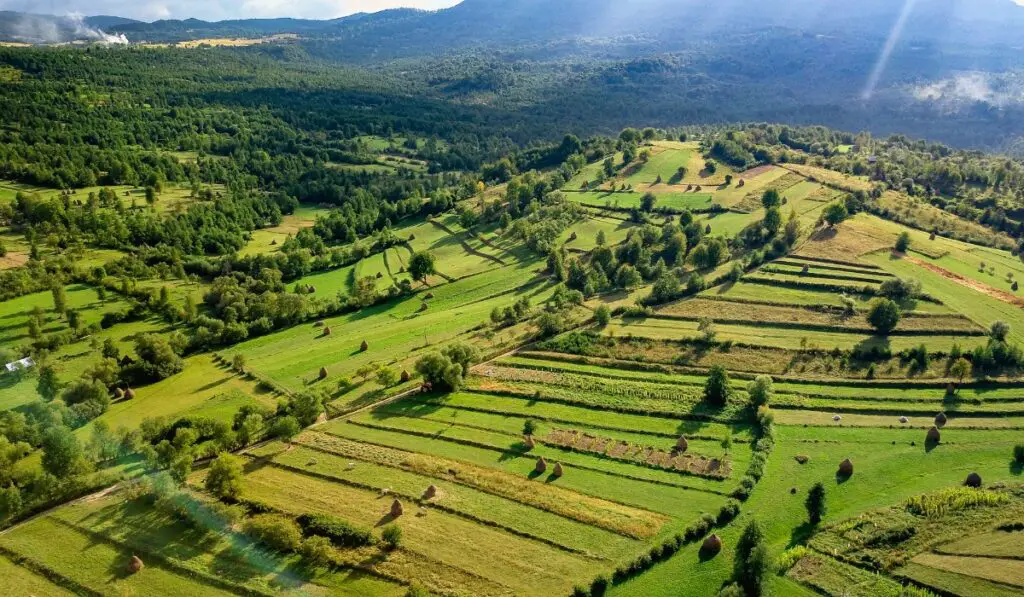
Embracing the Magic During Your Romania 7 Day Itinerary
Embarking on this Romania 7 day itinerary provides travelers with an unforgettable journey through the heart of Transylvania and its captivating cities. From the bustling streets of Bucharest to the historical charm of Cluj-Napoca, every corner of Romania promises a blend of rich history, scenic beauty, and cultural vibrancy.
Whether you’re drawn by the tales of Dracula, the medieval fortresses, or simply the allure of undiscovered gems, this Romania itinerary is your passport to an adventure like no other. As you reflect on your journey, one thing becomes clear: a week in Romania can leave an indelible mark on the soul, igniting a desire to return and explore even more. Safe travels!

